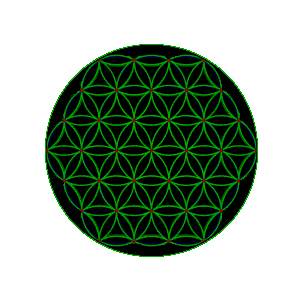- Lesson One: The Number One
- ... in Geometry
- ... in Nature
- ... in Culture
- "Uroboros" (related artwork by the author)
- "Creation" (related artwork by the author)
- Lesson Two: The Square Root of Two
- ... in Geometry
- ... in Nature, Part 1
- ... in Nature, Part 2
- ... in Culture, Part 1
- ... in Culture, Part 2
- "Duality" (related artwork by the author)
- Lesson Three: The Square Root of Three
- ... in Geometry
- ... in Nature
- ... in Culture
- "Vesica" (related artwork by the author)
- Lesson Four: Phi, or the Golden Proportion
- ... Intro, Part 2
- ... Intro, Part 3
- ... in Geometry
- ... in Nature
- ... in Nature, Part 2
- ... in Culture
- "The Flower of Phi" (related artwork by the author)
- Lesson Five: The Five Perfect Solids
- ... Intro, Part 2
- ... The Tetrahedron
- ... The Octahedron
- ... The Cube
- ... The Icosahedron
- ... The Dodecahedron
Every time there is a perceived duality, there is a way to join the two opposites back together into a perfect unity again - a unity which has grown from its original state because of the fact that it was split into two separate parts. Once the original unity is split, each half possesses specific and definite characteristics, whereas before there were no characteristics because their was only unity. Now those characteristics have been clearly defined, and the ensuing struggle between the opposites has created movement within the original unity. With the advent of the square root of three, this movement and adversity have been taken to the next level - rejoined, yet not cancelled out. The result is an end product which is not only the sum of its opposing parts, but something far greater.
Christianity is perhaps responsible for the greatest popularization of the vesica piscis, as well as its associated meaning. Particularly in medieval times Christ was portrayed within the confines of the vesica piscis, undoubtedly meant to accentuate his role as conjoiner of heaven and earth - God and humankind. When viewed in light of the fact that Christ was intended to be understood as humankind's bridge to God - a sort of fountainhead between the material plane and the spiritual plane - it becomes clear that Christianity is in fact a cult of the vesica piscis, whether it knows it or not. Apparently, especially so in medieval times, Christianity was well aware of the fact that this is true. It is no coincidence that the fish as been used as a symbol for Christ for hundreds of years, and it is a common site today to see bumper stickers on the cars of the United States depicting the simple outline of a fish - representing the car owner's faith in Christ, the conjoiner of opposites.
 Original artwork created by A. O'Connor for Nature's Word using POV-Ray and Adobe Photoshop 5.0.
Original artwork created by A. O'Connor for Nature's Word using POV-Ray and Adobe Photoshop 5.0.In more ancient times, the vesica was also taken as representative of the creative aspect of the Mother Goddess. The symbol was taken as a quite literal image of her genitalia. It is also interesting to note that a complex geometric image which is wholly based on the vesica was found carved into the wall of an Egyptian tomb, pictured below in negative. This symbol has come to be known as the "Flower of Life," and is believed by some to contain a map of the creative process which is inherent in all parts of this universe.
Tying together the symbolism of fish, Christ, and the Flower of Life we have the ancient Egyptian myth of Osiris. That Osiris and Christ play a similar role in their respective mythologies is clear - Osiris was first lord over the material realm, and after his death at the hands of his brother Set he went on to become lord over the spiritual realm. One of his many titles translates to "Lord of the Two Realms," and what better label for conjoiner of opposites?
In the particular myth relating the events of Osiris' death, we find the symbol of the fish at the moment of the victim's crossing from one realm to the other. It is said that when Osiris was slain, Set cut him into fourteen pieces, throwing each piece across the earth in a different direction. Isis, Osiris' faithful wife and companion immediately set out to gather all the pieces together, hoping to reanimate her slaughtered partner. She found all the pieces but one - his phallus, which it turns out, landed in a river, and was immediately devoured by a fish. Isis managed to bring her husband back to life, but it was to a different form of life - as lord of the spiritual realm. Osiris had lost his power in the material world, symbolized by the loss of his fertile member, but in doing so he crossed the boundary between two realms, and thereby he became lord and master of both realms - joiner of irreconcilable opposites. And what is the symbol that we find which propels him into this role? The fish.


